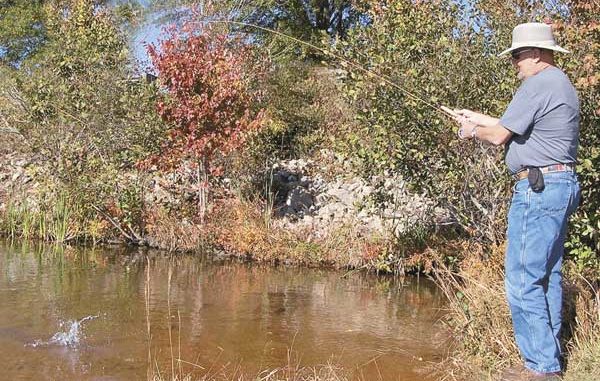
May heralds the season of excellent action for fly-rod bream in smaller Upstate lakes.
Want in on some hot bedding bream action? Try fly fishing an overlooked Upstate lake.It is likely that more books have been written about fly fishing than any other method for catching fish. Writers wax poetic about high-dollar bamboo rods used to make the perfect presentation of hand-tied dry flies in order to match the hatch for majestic mountain trout. That conjures up scenes from the movie A River Runs Through It.
While this type of fly fishing has had and maintains a tremendous following, most of the water accessible to South Carolina fishermen doesn’t exactly fit into that category. Subsequently, anglers tend to consider fly-rodding as a trout-specific tactic.
However, as many fly-casting fans are beginning to discover, just about any type of fish that can be caught on conventional tackle can be caught on fly tackle. Moreover, fly casting can be one of the best tactics for taming some of the most aggressive and widespread species in South Carolina’s Piedmont region. That’s why, during the full-moon periods of May and June, you’ll find Barry Brown of Taylors working the local water-district lakes with a fly rod in his hands.
“It’s not hard to learn how to fill up a cooler with bream this time of year,” Brown said. “Plus, you don’t need a fancy fly-fishing outfit or hand-tied flies. Your best bet is a handful of small, colorful popping bugs that you can pick up for a couple of dollars at Wal-Mart.”
With the growing popularity of fly fishing, tackle manufacturers have begun putting less-expensive and more user-friendly fly rods and combos on the market. A good-quality combo can be had for about the same price as any baitcasting or spinning outfit. Like spinning and baitcasting, it takes a bit of practice to learn to handle a fly rod.
“The trick to casting a fly rod is to remember that you’re casting the line, not the lure” Brown said. “I’ve helped several fishermen learn to fly fish, and almost all of them start out flailing at the water trying to get the lure ahead of the line.”
“Working the rod from the ‘10-and-2’ position, draw the rod and line backward to the 2 o’clock position, and shoot the line forward by flicking the rod forward to the 10 o’clock position using your wrist and forearm,” Brown said.
Trying to push the rod forward into the cast — as is done with baitcasting and spinning tackle — won’t allow the fly line to lay out and present the bait to the fish. For bream fishing, small popping bugs and flies provide almost no weight, so the weight of the fly line has to propel the bait forward.
Another aspect of fly fishing for smaller species is that the reel’s primary purpose is for storing line, not for fighting fish. Retrieving a bream is much easier to do by stripping in the line.
“I hold the rod in my casting hand and let the fly line slip through the fingers of my other hand,” Brown said. “This way, I can pop the bug and set the hook without having to load the line back onto the reel.”
Fly rods are sized-based on line weights. A good panfish or trout-sized rod is in the 3- to 5-weight range. Rod length is a matter of personal preference, but rods don’t need to be too long for bream fishing. A 7- to 9-foot rod will meet most needs.
The fly reel’s basic function is line storage, so there’s little need to buy one with lots of bells and whistles. A basic reel of decent construction will service the bream fisherman for many years.
Fly lines come in a variety of styles. “Weight forward” line has become the industry standard, and floating line is preferred since the water in which bream bed is rarely deeper than four to five feet. From there, the fisherman can get as fancy or as basic as he or she wants. A monofilament leader can be made with a rod-length of 4- to 6-pound monofilament, or the fisherman can buy special leaders that taper from 10-pound test down to a 4-pound tippet.
As with any lure, match the size of the bait to the size of the fish. Bream have small mouths, and bugs and flies with smaller hooks in the size-10 range will hook more fish. Larger baits with larger hooks are acceptable for the biggest bream and the not-so-occasional largemouth bass that shows up.
“Bream are a very forgiving fish,” Brown said. “Even novice anglers who are still learning to cast can catch some good bream during May, because the fish are guarding the nest and will hit almost anything that lands within their radar.”
Locating a bream bed is more than half the battle. Typical bedding habitat will be muddy or sandy bottoms in shallow water around structure such as docks, brush or rocks. Once a bed is located, it’s important to keep at least a cast’s distance off the bed. Using a trolling motor or positioning a boat too close to the bed will scatter the fish, and you may have to wait a day — or at least several hours — for the quality fish to return.
Look for beds to be located in the shallow, flatter areas in the upper reaches of most lakes. If an area contains a large bream bed close to shore — or if you are fishing from the bank — it’s a good idea to walk the bank or wade in the area and cast to the fish. Care should be exercised not to let your shadow cross the bed to keep from spooking fish.
South Carolina has an abundance of bream waters statewide. Just about every body of freshwater in the state, from small farm ponds to major reservoirs, has a bream population. One of the most overlooked areas in the Upstate is a series of water-district lakes that cover Greenville, Spartanburg, and Laurens counties. Locally known as the “Greer Chain of Lakes,” these small bodies offer untapped bream fishing at its best.
Lakes Bowen and Blalock
Owned and operated by the Spartanburg Water System and Sewer District, these two lakes in the northern section of Spartanburg County, are the largest in the area.
In 2007, Spartanburg Water System completed a project to raise the level of Lake Blalock from 700 to 710 feet above sea level. This required raising the dam by 10 feet and clearing the surrounding shoreline. Blalock covers approximately 1,200 acres.
“The raising of the lake level is expected to have a positive impact on shallow-water spawning grounds for both bream and bass species,” said Eddie Dearybury, the lake warden who presides over Blalock and Bowen.
“Before we raised the lake, people caught some tremendous bream out of here; it was good then. This year will tell how much better it will be.”
Lake Bowen, just east of Blalock, has approximately 55 miles of shoreline, much of which is developed. There are a lot of boat docks, brushpiles and isolated laydowns.
“We have a good many anglers who come to Bowen in May just to fly fish for bream,” said Dearybury. “There’s not one particular hot area; anglers mainly target docks and brush all over the lake.”
Lakes Lyman and Cooley
As the water provider for the towns of Startex, Jackson, Wellford, and Duncan, these two water-district lakes near the western border of Spartanburg County represent flat, shallow-pool reservoirs with plenty of shoreline cover — prime habitat for spawning bream species.
Lyman, a 500-acre impoundment of the Middle Tyger River, is the older of the two publicly accessible SJWD reservoirs and contains much old development along the shoreline in the form of docks and piers. These locations are magnets for spawning bream.
Lake Cooley is the 300-acre sister impoundment of Lyman. Cooley is characterized as a “bowl-shaped” reservoir with no well-defined channel. The upper section, above the SC 292 bridge, is a large, shallow flat that stretches between the bridge and a culvert pipe flowing under Ballenger Rd. This entire area can be prime bream bedding areas.
According to Jamie Wofford, the lake warden, “Most of the anglers I talk to have good success for bream all around the edge of the lake, which is a shallow slope. Anywhere there are brushpiles or blowdown are pretty good for bream during the spring.”
Lakes Robinson and Cunningham
Owned and operated by the Commission of Public Works of the City of Greer, lakes Robinson and Cunningham in northern Greenville County, offer two distinctive types of terrain for bream fishing.
At 840 acres, Lake Robinson is the larger and newer of CPW’s facilities. While it is wide and deep for a small impoundment, much of its shoreline is gently sloped, similar to Lake Cooley. While the shoreline is widely developed, there are many pockets and coves, especially at the backs of several of the small tributaries that feed into the lake, that will hold bream.
Another great option is the myriad of boat docks that line the shore. While these docks are restricted in their length and are too shallow to hold many fish, boat docks located over or near deeper water are good spots to try.
On the other side of the Robinson dam, Lake Cunningham, recognized by many old timers as “Greer Lake,” is riverine in nature and winds its way out of Cunningham Swamp to its dam near the CPW water plant. Cunningham is also developed, but many of the docks and shoreline structures are older. The lake is bordered by broadleaf aquatic vegetation that is a bream haven, especially above the SC 101 bridge in Cunningham Swamp.
Lake Rabon
Lake Rabon is a 540-acre lake operated by the Laurens County Water commission. The reservoir is “V” shaped with two separate tributaries, North Rabon Creek and South Rabon Creek. It is about 10 miles west of the town of Laurens.
According to Tom Thomason, the lake superintendent, “Rabon has good numbers of bream, and a lot of people come in with kayaks to fly fish along the banks. In fact, kayakers and other paddlers have been our main growth of lake users over the past couple of years.”
Lake Rabon has a mixed bag of bream species, with shellcrackers making up a large percentage. Local fishermen also note plentiful catches of warmouth in the spring. These fish congregate around budding willow trees along the lake, looking for fallen insects — making popping bugs a prime bait.
“The right fork is where North Rabon, Leaf Creek, and a couple of smaller no-name creeks come into the lake. There’s a lot more freshwater coming into that side, and that’s usually the best area to look,” said Thomason. “Once you get into the upper end, it shallows up, and that’s the best place to look for bream beds.”

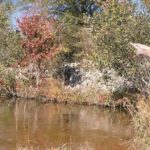

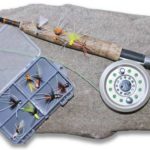
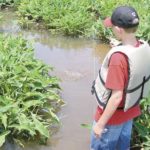
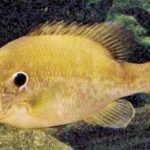



Be the first to comment